A bit of a disclaimer here; I first met Derek Durst back in the 1980s, when he had in his possession one of the Le Mans HRGs. We wrote a story about the delightful Hurg and the article appeared in “Sports Cars International”. When Brandy Elitch’s story on the Delage and Ferrari in the barn was published last week, Derek wrote us a nice note to explain why he had a) changed the body and b) why he had run the ad on eBay in that fashion, which caused a good bit of confusion and speculation. While we fully support the views of both Brandes Elitch, the Delage clubs and Registries, we thought it only fair that Derek be given the chance to clarify a few issues. [Ed.]
By Derek Durst
I am a lifelong car-guy, a genuine car enthusiast albeit with a background in art, I am not a writer, but I feel obligated to respond to the above article in my own defense, as best I can.
First of all, I would sincerely like to thank the literally hundreds who have written to me to voice their congratulations and support for what I have tried to do with this Delage car. It has been as gratifying as it has been overwhelming and I have tried to answer as many as possible.
To those few who have shown a negative response, I can only say that I have never misrepresented this car in any way. My initial eBay ad clearly stated that the “barn find” photos were staged and not to be taken seriously, and I was amazed that anyone did. To eliminate any misunderstanding, I replaced the original ad with another that spelled out in detail the changes that had been made to the car.
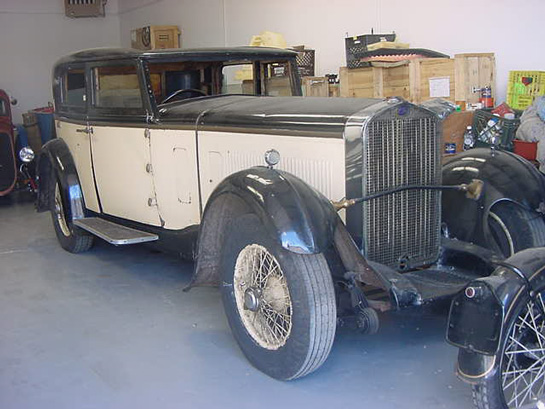
As found. 'The lads at Auto Restoration would confirm that it was pretty horrible in terms of corroded metal and rotten wood. The paint was absolutely not original although the previous owner was under the impression that it was.'
When cars such as my 1930 Delage originally left the factory, they had no body at all, they were just a chassis and a buyer would have the chassis sent to the coachbuilder of his or her choice for bodywork, either from a catalog of body styles or a completely unique design, sort of like going to a tailor for a bespoke suit of clothes.
When I acquired this particular car, the sedan body it carried was truly in very poor condition with important pieces missing such as the complete windscreen, a large part of the roof, and other important parts. The wood framework was rotting, the doors were hanging, tied up with rope, and the body was literally collapsing over the chassis. Clearly, the bodywork was beyond restoration and the best I could hope to do with it would have been to build a brand new replica of the original body but let’s be clear, this is not restoration, this is replica building which brings up another important point.
When cars such as this were built, many of them were not that good. I have personally seen original hand-crafted cars having opposing doors of very different size, and even made of different material. I recall one very original Ferrari that I owned that had one front fender a good two inches higher than the other front fender, and it had clearly been made that way. Of course, inconsistencies such as these will not be tolerated in a contemporary “restoration” which begs the question, are these cars restored or are they replicas? If a car rolls out of a restoration shop having an entirely new body, just like the original body, but cleansed of every original quirk and inconsistency, made perfect, with paint and chrome more glossy and more shiny than the original ever hoped to be, is that a “restored” car or is it not a clever, and perfect, replica of itself?
The original “suit of clothes” on this Delage had clearly worn out and was beyond restoration so, I made the choice to order a new and different suit and I will stand by that decision. I believe I did the right thing. The car is a far more handsome machine in its new suit than it would have been in a replica of its dowdy old sedan “suit”. After all, would you wear the same suit of clothes for 80 years?
It has recently come to my attention that the 1930 D-8 referred to above was originally owned by the well known lady rally driver, Kitty Brunell. I would like to think that Miss Brunell would approve of the new “suit of clothes” I have put on her old sedan.
The car has attracted some serious interest but is still for sale. It is my hope that any new owner will view ownership with the same lighthearted, honest approach that I have taken.
The D6/70 (# 51540)
The story of my previous Delage, a 1939 D6-70 that I also re-bodied is similar. I purchased this car sight unseen from a seller in Australia and the car looked pretty sound in the pictures though wearing a not terribly inspired, two door sedan coachwork by Letourneur et Marchand which, upon arrival and close inspection, proved to be loaded up with rust, rot, and bondo, although the car ran and drove extremely well. I drove this car for a period of time as it was, but soon tired of doors and windows that failed to close or operate properly. Restoration was possible but would need to be as extensive as it would be expensive and, as I personally found the body design to be breathtakingly mediocre, I made the decision to exercise my own artistic talents and design a body that was not a copy of anything but was, nonetheless, in the style of the great French coachbuilders of the 1930s albeit viewed in a 21st century rear view mirror.
I made sketches and drawings and then I personally oversaw the actual construction on a daily basis, making tiny changes of a half an inch here and a quarter of an inch there until I had driven the craftsmen doing the actual work out of their minds but I was satisfied with the result. Again, I justify my approach as simply fitting a new suit to an original Delage chassis hoping that it will be judged on its design merits rather than any sort of failure to pay proper homage to what I considered to be a not very exciting catalog sedan body. I believe that this car has now passed through several hands and it is my sincere hope it has brought as much pleasure to them as it brought to me in making it.
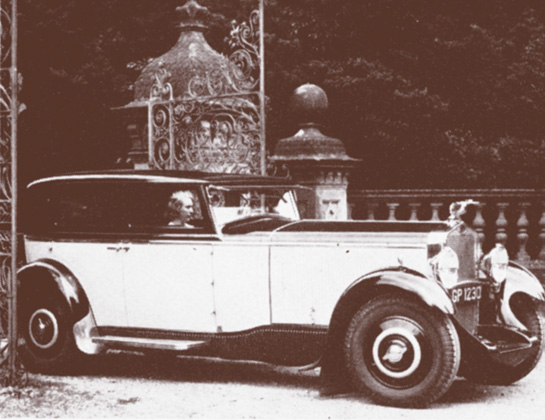
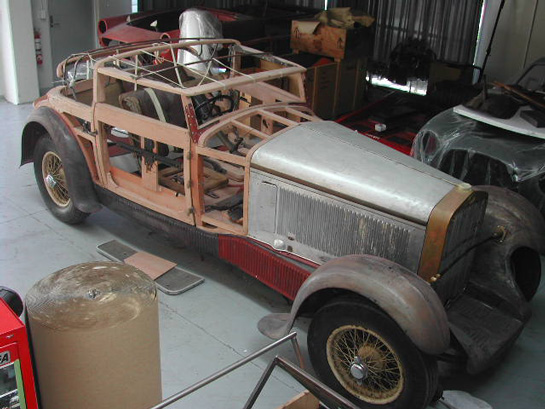
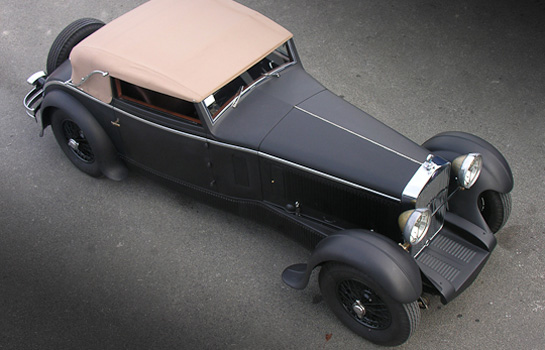
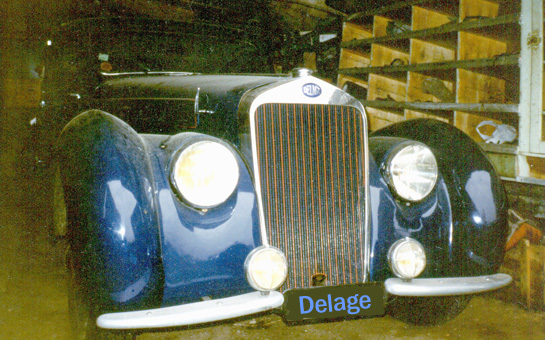
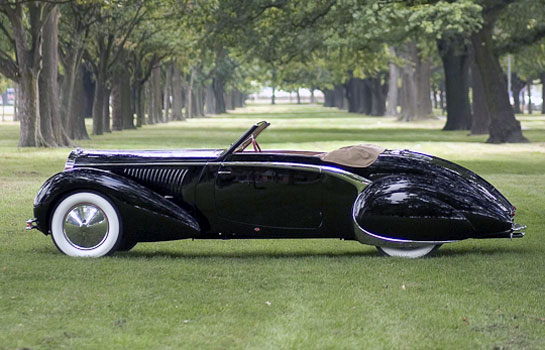
a beautiful car is a beautiful car, forbidding recreation of a thing of beauty would be a loss for all future generations. Actually viewing or owning the ‘original’ would be very special, but I would always love to own a recreation if the original was beyond reach. Afterall, when I saw the Mona Lisa I was actually disappointed as to its size, I would rather have a reprint.
Derek,
Thumbs up, on both your attitude and your cars! Of course, I drive a “butchered” boy-racer XK120 that makes everyone but the Concours boys smile, so I’m probably not the most neutral of responders.
Jack
Your rebodied D6 is a masterpiece!
Beauty is in the eye of the beholder and you have done well. As a long time Porsche owner, I have been berated by die-hard 911 owners for purchasing a fantastic four door Porsche because it isn’t a “real” Porsche. To all these and your critics, I say eat your heart out if you must, the world continues to rotate and the sun comes up every day.
Both the D-6 and D-8 are more beautiful now than when they left the coachbuilders of the original owners, IMHO. I commend you.
I was not much into Delages, but in the day I to owned HRG Aero Lemans, Ser.#LW129, Engine #C171Q. It was an enchanting car, which I drove everyday, and it could out-corner a Porsche, easily, with one front wheel dangling in the air. Unfortunately it also had a tendency to shake its body apart, and shed pieces in the road. I got it by swapping for an old Singer SM1500 with a broken axle, and eventually cornered over-exuberantly on wet leaves and into a pole, bending its fragile chassis. I sold it to Sy Kaback, who was racing a conventionally bodied HRG, he wanted the Scintilla Vertex Magneto which I had installed. The car was exceptionally reliable until its demise. – Don Falk
I responded to the second Ebay listing, unaware of the first. Derek wrote back immediately, and I knew from his remarks that both Derek and the car were the real deal. He was very clear in his discription of what (and why) he had done and I would have done exactly the same thing with the dowdy old sedan……and so would have the George Barris, Gene Winfield, Donald Healey and Bizzarini’s of this world.
Derek frowns on today’s over restored cars as many of us do. Fortunately PB, Amelia, Itlalia Concorso and others have seen the light (actually Bill Warner always has) and offer classes for originality. Many are finally coming around to what our old friend Bill Harrah preached, and lived, years ago. Good original cars are the best, but if beyond reasonable restoration, or if, like Derek you have the good taste to improve upon what is there………..do it!
A toast to you, Sig. Durst, El Bumpo!.
Your efforts have added beauty to the World . Anal retentives seldom do. Tom
As the saying goes, f*&k ’em if they can’t take a joke. Those cars are beautiful in my opinion. A work of art is a work of art. Two cars were saved that otherwise would have been scrapped. I think some of those champagne and caviar people can’t see past their own ignorance.
No controversy in my mind. You did the obvious and what most of us would have done.
Great job!
Dorien
Well, I cannot agree here with Mr. Durst!
Of course anybody can do what he wants with the object he purchased – but this is not the issue here!
But why did he purchase an old, historic car? For me the aquisition of this is to get a part of automotive history, the aura and the individual history of such a car! And yes, those high-class cars of the 30s came only as a chassis plus engine, suspension and wheels. The coachwork was made to the taste of the then-time-owner. But this is history and for sure a very individual history of such a car.
Almost (!) everything can be restored today and to replace a wooden frame that is rotten away is not easy but possible.
No doubt that your new coachwork-creations look breathtakingly beautifull, but you took away history of your car(s).
And -btw.- I agree with you about 80 year old colths. But when it comes on designers like DIOR, FERRAGAMO, CHANEL, SCHIAPARELLI (all from the 30s) – their clothes were masterpieces and are collected today, many of them in various museums. Delage belonged to that sort of design masterpieces and they should have preserved in the style they were created!
Or would you change the color of the Mona Lisa only because you don`t like that ol`brown…?
Walter Baumer
Maserati Historian
My view of these things is that the man owns the car and he can do with it as he pleases first and foremost. However, equally we are free to comment on the idea
and execution of the project. It is interesting to note at the very end of Mr. Durst’s
story he says he hopes the new owner enjoys the car “as much as I had MAKING it”
“Making it” is an interesting way to view the car. I do agree with Mr. Durst that these exception makes of cars produced as “chassis” to be bodied by whomever are
a bit different then say a new Porsche which being unit bodied is of-a-piece one unit.
The older style “chassis” only in fact is the car that came out of the Delage works
and the body being a different part not a Delage creation can be changed as Mr. Durst characterizes it like new suit as the original owner likely viewed it. In fact the
“chassis only” cars like Duesenbergs and such were frequesntly rebodied by the owners rather then changing the whole car. AND Mr. Durst did a spectacular job on the earlier Delage and very much in keeping with the time and style! So my view is “good job” Mr. Durst and please let us see your other work in the future! Thanks
I’m really of two minds with this car and story. I came to it on Bring a Trailer and was initially disturbed by the first ‘fake’ listing (mostly in its violation of the terms-of-service. It was clear there was something perhaps intentionally funny with the listing.)
To me, there’s no question that the new bodies of both Delages are beautiful, and I don’t doubt that the craftsmanship matches the artistry. But I do bemoan the loss of the original bodies, as my untutored eyes tell me that the bodies look recoverable. I don’t know what happened to these remnants; but perhaps something could be done to restore those pieces for use on a totally dis-bodied Delage, because that coachwork represents automotive art as well. That’s why the story of the seemingly wanton sundering of the early Pininfarina Ferrari 212 that was ‘paired’ with this Delage story seems more disturbing. But the starting premise and argument, that the coachwork is ‘independent’ and historically was often changed on cars of this era, is a good one.
That “dowdy old sedan” was actually very handsome. For too many years the prevailing mentality has been to discard sedan bodies in place of something else. The truth is the closed cars offered during the Classic Era usually represented the finest coachwork offered by automobile manufacturers. A few many have been dowdy, but each had its historical significance. Its a shame to lose them.
The whole process of restoration/refurbishment/replication / recreation is an emotional minefield of human reverence and appreciation for the past. As a Designer I have empathy for designs of the past, I also love to use/ live with Automobiles with character, Buildings with style, innovative furniture etc etc. But at the same time I do not want to drive daily in a motor that is less safe on today’s roads than a modern car. Neither do I need to live in a Building with nil insulation or hot water or sit in an uncomfortable chair . The curator school of thought wishes for all these things to be preserved in aspic ( in a museum ). The custodian view seems to be keep them as they were made and use them even if they are falling apart. The replica designer tries to produce a design as it might have been either starting from scratch or using what is left of a delapidated original .Mr Durst has made some beautiful recreations of 30’s style autos . I know of many Autos in museums that do not run, here in the UK we have a regular run every November for veteran cars from 1903 – to the 20’s there are also a plethora of vintage cars ( pre WW2 ) club events. We love to USE our cars and feel they need movement, it is their element. Enjoy them but do not treat them as static objects.
Christopher Moorey.
Frankly, it would seem that someone’s carburetors were not attuned properly to the thin and refined air that we have here in Santa Fe, at 7,000 feet.
I honored to have known Mr. Durst personally for years now, and have seen the car personally awhile back.
He fully explained everything he did to the car and I could easily observe that there was a tremendous amount of highly skilled ‘carrosserie’ effort put into it.
It is a marvel to behold and Mr. Durst’s honesty is far beyond reproach.
I say that as a somewhat serious automotive aficionado myself, of 50 years standing.
This is a never-ending, very interesting discussion! I guess there is a significant difference between a museum vehicle, which preferably is very original, has very little mileage, in other words very little active history. On the other side a race car or sports car from the 30’s, this has been driven in all sorts of events for over 70 years and still does. The original body can not be kept all that time. Such expensive cars where re-bodied often for a change only, not because of wear. But if not, sooner or later a bigger job is needed for a realy old car. Wile doing such a tremendous effort, you might as well do it better looking and safer. The importance is, the cars designing matches to its active time and the owner has lots of joy with it.
I for one did see the first Ebay listing for the Delage and, perhaps because I didn’t pay close attention, was totally mislead to think that it was a “real” car discovered in that condition. And I was not the only one to have been fooled. I also believe that the questionable nature of the listing is why it generated such interest and then required a “retraction” listing describing it for what it is.
These Delage rebodies are beautiful works of art in their own right. But they are not historical, and they have erased the history of each vehicle. However, I don’t fault what Mr. Durst has created – I would like to do the same as an experience of historical coachbuilding.
However – if I were to sell the car, I would have listed it for what it was – a modern rebody – and not tried to mislead the public with a tantalizing “barn-find” description.
Around 40 years ago, as a student at the Rhode Island School of Design, I spent a Winter working for Derek as an intern in his one man restoration shop. I couldn’t wait to get to the shop, and Derek had to practically throw me out. He seems to have retained the passion he had back then. He let me design a new shop for him at his estate in North Dighton (energy efficient for its time). At the time, I was an Architectural student looking for diverse experience, and loved old cars. I went on to participate in various historic restoration projects in my career, and I have a clear, personal point of view about history. What I came to appreciate is that today is as valid in the course of time as was yesterday. A building built in the 1800’s, with later period additions is viewed in the context of each era.The 1800 original building, the 1910 addition, the 1930 wing all add to the overall historicity of the structure. So too with Derek’s work on the subject cars. Just because something is old and original does not make it good or valuable. Often the later design, craftsmanship and materials make for superior adjustments. Sometimes people butcher things with their adjustments, other times, they enhance the beauty and value. The later work is just as important as the original. If the cars are around fifty years from now, the new coach work may well be considered the saving grace of the car.
Derek, Iremember your D6/70 from when I was living in Australia. Both the D8 and the D6/70 look superb. I amnow in Dunedin and I am rebuilding my Delage DMS. The original body is very similar to your D8. Do you have any more phoos of the roof prior to being covered? Are you residing in NZ? If so I would like to make contact.
By chance… did this Delage come from Texas? Years ago (in the early 8Os) I helped Mr Fred Tycher load a Delage and a Pierce Arrow onto a trailer headed for Dallas! That Delage looked just like this one! I’ll have to look for the photos that I took that day! Fred bought the cars off of Mr Bill Lationo a classic car collector from Elyria, Ohio! Bill had a lot of nice cars! Fred was a frend of my late father Richard Law ! Dad had a few cars, he was real fond of his 1933 Pierce Arrow Labaron body convertable coupe! Sadly …he never got to finish it! And all those years walking mile after mile at Hersey with the “Wanted Pierce Arrow Parts” sign on my front and back was all for nothing…But what a great time it was!!! Scott
Hi Derek, after years of trying to find you and Mary Ann I found this article. I would love you to help me get in contact with Mary Ann.
Hope this will reach you for the article is from 5 years ago.
Thanks a million,
Rimke
One of my greatest joys was working for Derek for 6 weeks during my time at the Rhode Island School of Design. When I told my school advisor I was using the 6 week Wintersession to experience car restoration, he was enthused. He actually thought I said “art” restoration.
How are you, my dear cousin. Just checkin’ in. I don’t usually leave messages, but hey….why not? I just think about you from time to time and hope you are still wrenchin’ and doing what you love. Your long, lost cousin from Cali….Virginia Frances Edwards.